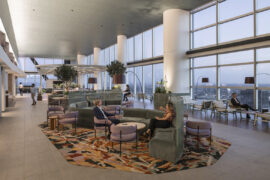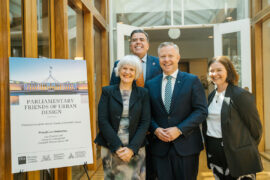As global sustainability leader with Woods Bagot, Russell Fortmeyer takes a clear stance on leaders’ roles in spotlighting sustainability as the reigning imperative of our times.

April 8th, 2022
As part of their dogged commitment to challenging the status quo in almost every aspect of architecture and urban design, Woods Bagot has appointed Russell Fortmeyer as global sustainability leader to spearhead the firm’s sustainability initiatives. Elana Castle asks the global sustainability expert about his approach to the role.
You have a background in architecture and engineering. What brought you to this particular area of work?
I started my career in the late 1990s just as our industry started to wake up to the idea of sustainability in light of scarce resources and obvious signs of climate change caused by human development.
As a longtime environmentalist since I was a kid, it just made sense to me that I should take a critical view of the work I did in my professional life to understand how I could make less of an impact on the environment.
Russell Fortmeyer, global sustainability leader, Woods Bagot
Although I began my career as an electrical engineer, it became quite clear to me that sustainable imperatives cut across the way our industry has organised itself into disciplines. In that regard, I think having training in both architecture and engineering has served me well in not getting caught up in the motives of one specific discipline.

What is your overarching goal in your role at Woods Bagot?
I think anyone’s goal in sustainability in any industry should be to transform our work from extractive to regenerative. We cannot keep consuming at the rate we are on this planet and not continue to have unacceptable outcomes that challenge our commitments to social justice, biodiversity, and economic equality, among many other things.
A regenerative model of sustainability is one that at a minimum looks to neutralise our impact, or our footprint, and then build on that to contribute a positive benefit within whatever system boundary we are operating. For example, the increased interest in mass timber structures in architecture is a design push to sink carbon from sustainably managed forests into buildings – when we replant that forest, we sink yet more carbon from the atmosphere.
I think it’s exciting that these conversations are now common in architecture in a way they weren’t before, thanks mostly to increased awareness and data on our real impact. My goal is to facilitate this kind of dialogue in our global studio, finding ways to connect good ideas across Woods Bagot to move forward on climate action with our clients.

What do you see as the primary challenges in our current state of environmental affairs?
Where to begin? What I’ve said for years – and I’m by no means the only person who has ever had this thought – we have the knowledge, technology, and capacity to achieve our sustainability goals in a country like the United States. We even have the money to do it.
What we don’t have is political leadership that knows how to direct that money toward sustainability.
Russell Fortmeyer, global sustainability leader, Woods Bagot
From my desk in California, I see that changing mainly because we do have political leadership that gets it, but more significantly, the private sector in this state has seen real disruption to their businesses directly because of climate change. No one in the private sector is investing in sustainability because they want to feel good, they are investing because they need a resilient business that can continue in the face of sea-level rise, wildfires, extreme heat, horrific air quality, and on and on. And their investors also increasingly expect it.
The challenge we have in architecture is articulating the risks to our clients if they do not invest in design that can adapt or even mitigate the effects of climate change on their operations going forward. Yet, as much as the investment community has woken up to the idea of climate risk, one of our other key challenges is aligning those investments in the built environment with the imperatives we have for social justice.
We cannot just jump into climate action without understanding how we bring everyone along, especially the most vulnerable populations among us.

You cover many areas in your work. Climate change, social equity, human health, green technologies, resilience planning, decarbonisation, urban microclimates and human comfort, are a few examples. Can you describe how you address these issues (and opportunities)?
I’m being a bit simplistic by using the word sustainability as a stand-in for all these interests since sustainability is so broad it’s effectively meaningless as a word. My days are all over the place and I like that.
One minute I might be talking through the implications of a zero-carbon goal on a master plan in Perth and the next minute I’m talking about how the biases in human thermal comfort models used by engineers in architecture contribute to inequitable and ultimately unproductive office environments.
Sustainability requires an incessant curiosity about the world and a willingness to challenge conventional thinking, which means I spend a lot of time reading research, policy reports, and design and popular media, but also knowing where to look for that given the popularity of slapping the word sustainability on anything.
But to me, every project or dialogue starts with understanding your client’s goals and mapping those onto the key sustainability drivers. You aren’t going to achieve anything on a project if there’s not a clear value that you’ve articulated with your client. I know that not all of my clients are sitting around thinking about the same things I am, so I have to understand their focus, so whatever it is I bring to the table resonates with them. If I can win their confidence that way, I can challenge them a bit more and push what we can achieve together.
Can you elaborate on Woods Bagot’s Global Impact Group?
Our Global Impact Group, or GIG, pulls together leadership across our studios to set the agenda for how we respond to the climate crisis through our internal structure and operations, as well as our work for clients and contribution to the industry.
While a lot of firms may have sustainability committees amongst leadership, our GIG members are all involved in project design and delivery, so they really have a view on the challenges and opportunities I’ve already discussed. That enables the group to focus on what could deliver the most meaningful impact.
For example, GIG conceived and developed a digital environmental performance toolkit that is now embedded in Woods Bagot’s design process, which makes it easier for our project teams across the studios to bring modelled evidence of sustainable design strategies to our projects so we can help clients make informed decisions.
In many ways, GIG is about transforming our design culture to meet the climate challenge – it’s a bigger view of how the firm can be impactful.

You are internationally recognised for your ahead-of-the-curve approach to ecological and environmental solutions. Can you elaborate on this?
I’ve been fortunate in my career to have had the opportunity to work globally in significant ways, some of which have been surprising even to me. In 2019, I curated the USA Pavilion, called RECKONstruct, at the Milan Triennale.
Now, the Triennale has been around for decades and it’s been a real force in avant-garde design, which is not necessarily something to which I ever thought I’d contribute. But the 2019 iteration of the exhibition, curated by Paola Antonelli, centered on the theme Broken Nature, or the idea that humanity has impacted the environment so much to the point where design’s primary role may be understanding how to patch it up, so to speak, or find ways to work within compromised ecological conditions to support biodiversity.
That appealed to me, so when the opportunity to propose an idea for the pavilion presented itself, I committed fully. At the time, I was at Arup, so we had a built-in design team that could start working with our amazing exhibition partners – Humanscale and Novita, as well as MIT.
Our pavilion set out to tell the story of materials lifecycle assessment, or the very tricky data analysis that accounts for the environmental impacts of a material used in the built environment from its natural source to how it’s processed, all the way to when it’s used in architecture and then ultimately discarded or reused.
That is not an easy subject to explain to a design audience, let alone the general public, so we created an immersive film that we projected on three walls of our pavilion to take visitors out of the museum, at least virtually, and walk them through a supply chain and lifecycle.
Even though this was not architecture in the conventional sense, to me it was just another approach to storytelling, which is what sustainability is on some level.
Russell Fortmeyer, global sustainability leader, Woods Bagot
It was also a way to celebrate the leadership the architecture community in the States has played in focusing attention on the materials we use—this is still a huge challenge for us in design, so I’ll take any occasion to shine a light on it.
Please describe some of the sustainability initiatives integrated into the Harvey Milk Terminal 1 project at San Francisco’s international airport.
Our credo at Woods Bagot is people architecture, which to me provides so much clarity of purpose for why a global group of architects would want to work together. It echoes sustainability’s triple bottom line, which balances people with planet and profit. And I see that very actively carrying over to things like how we do our work and the kinds of projects we pursue.
A good recent example is the new Harvey Milk Terminal 1 project at San Francisco’s International Airport, the first-ever terminal to achieve a Platinum certification using LEED version 4 – that’s no small feat. But we accomplished that remarkable outcome through intense collaboration, teaming with the airport and contractors, engineers, consultants, and other architects to implement a sustainable design vision that centres the new terminal around the experience of the people who work there and pass through it.
What do I mean by that? One aspect of the design that resonates with me is the quality of daylight you see throughout the terminal – this is such a critical way in which we experience a place, especially one in which the passage of time or geographic displacement informs how a person feels within a building.
Waiting to board or rushing to get dinner between flights is not necessarily high on a person’s list of ways to spend their time, so daylight in an airport provides a way to connect us to the natural cycle of a day, to the planet’s systems that tether us to a specific place – it may be subtle, but our bodies respond to that whether or not we are aware of it.
Balancing daylight with the demands for energy efficiency, such as with dynamic View glass, or a material selection that reduces embodied carbon emissions on such a large project can only be done when a design team can build trust, but also bring evidence to the discussion during design.
The benefit of a LEED certification, in this case, is that it independently confirms that all of this design and collaborative work produced the outcome we wanted based on the science behind the intent. I actually think that’s a critical point to make for a public entity, this idea of being transparent about what you achieve with such a major public infrastructure investment and taking that additional step to confirm what you’re doing isn’t just a bunch of talk. A
nd that sort of circles back to how I see my role at Woods Bagot, as a way to support the amazing work we’re doing globally by holding ourselves accountable in proving what we say we’re accomplishing in sustainability.

What should all designers be doing fundamentally to shift the course of climate change?
The simple answer is vote. If you’re not supporting political leadership who acknowledges the impact of climate change on our planet, then it doesn’t matter how many LEED buildings you design or recycled products you specify.
My other advice? Listen to young people.
Russell Fortmeyer, global sustainability leader, Woods Bagot
Climate change is the defining crisis of their lives and, frankly, I care more what a recent college graduate has to say about climate change than a CEO whose job may depend on them not caring that much.
Woods Bagot
woodsbagot.com
We think you might like this interview with Clive Wilkinson about corporate culture in a post-pandemic world.
INDESIGN is on instagram
Follow @indesignlive
A searchable and comprehensive guide for specifying leading products and their suppliers
Keep up to date with the latest and greatest from our industry BFF's!

For those who appreciate form as much as function, Gaggenau’s latest induction innovation delivers sculpted precision and effortless flexibility, disappearing seamlessly into the surface when not in use.

From the spark of an idea on the page to the launch of new pieces in a showroom is a journey every aspiring industrial and furnishing designer imagines making.

Merging two hotel identities in one landmark development, Hotel Indigo and Holiday Inn Little Collins capture the spirit of Melbourne through Buchan’s narrative-driven design – elevated by GROHE’s signature craftsmanship.

Designed by Woods Bagot, the new fit-out of a major resources company transforms 40,000-square-metres across 19 levels into interconnected villages that celebrate Western Australia’s diverse terrain.

The Parliamentary Friends reconvened at Parliament House, uniting political and professional leaders to champion architecture and design.
The internet never sleeps! Here's the stuff you might have missed

Boronia Apartments in Waterloo, designed by TURNER for City West Housing, delivers 74 affordable rental homes that combine sustainable design with long-term community-focused living.

AHEC has produced a documentary exploring forestry and stewardship through long-term forest management and human responsibility.